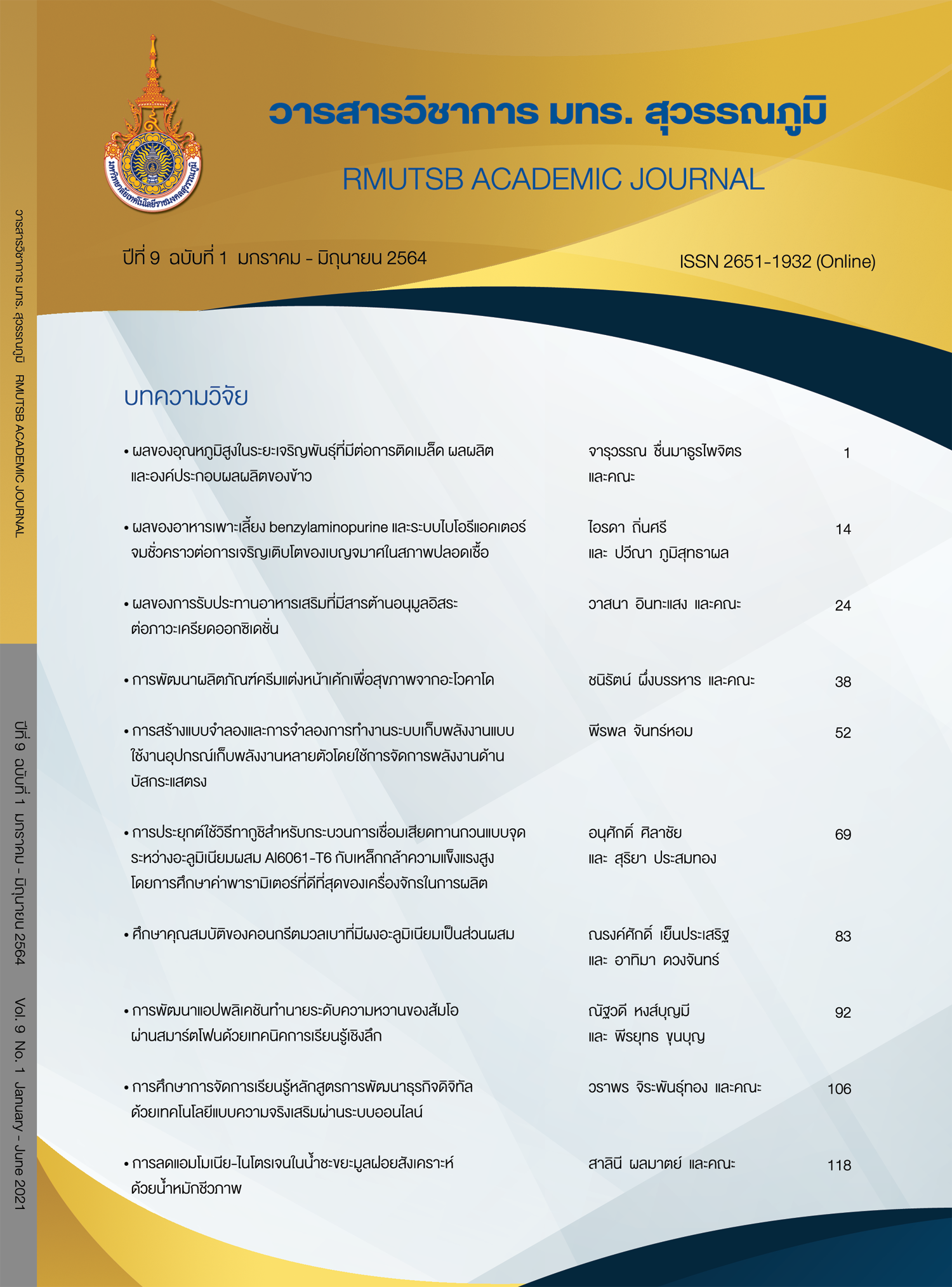The reduction of ammonia-nitrogen in synthetic leachate using fermented bio-extracts
Main Article Content
Abstract
Landfill leachate is defined as the liquid generated during the process of landfilling consisting high loads of refractory organic matter, inorganic salts, heavy metal ions high ammonia concentration and various toxic contaminants. In general, high ammonia concentration was not decreased with increasing the landfill age. This research aimed to study the reduction of ammonia-nitrogen in synthetic old and young landfill leachates using fermented bio-extracts. The fermented bio-extract used in this experiment was one month fermented time. The appearance was brownish yellow containing brown silts. It had a sour and sweet odor and a slight smell of alcohol with consisting of 4.66 mS/cm of conductivity, 3.67 of pH, 2.11×105 CFU/mL of bacteria, 2.88×104 CFU/mL of fungi, 1.47×103 CFU/mL of yeast and 2.11×105 CFU/mL of actinomycetes, respectively. The suitable concentration of fermented bio-extract was observed for reducing amounts of ammonia-nitrogen, nitrite-nitrogen and nitrate-nitrogen in synthetic old and young landfill leachates. The results showed that 1.0% of fermented bio-extracts reduced ammonia-nitrogen in synthetic old landfill leachate which showed the removal as 92.92%, while 2.0% of fermented bio-extracts reduced ammonia-nitrogen in synthetic young landfill leachate which showed the removal as 80.59%. The obtained results of this study could be used as a guideline for the biological reduction of the amount of ammonia-nitrogen in synthetic landfill leachates and used to combine with other landfill leachate treatments.
Article Details
Published manuscript are the rights of their original owners and RMUTSB Academic Journal. The manuscript content belongs to the authors' idea, it is not the opinion of the journal's committee and not the responsibility of Rajamangala University of Technology Suvarnabhumi
References
APHA. (1989). Standard methods for the examination of water and wastewater (15th ed.). Washington DC: American Public Health Association.
Beatriz, G. R., Amanda, L. S., Luiza, P. T. T., Adriana, A. O., Liséte, C .L., & Miriam, C. S. A. (2017). Organic compounds removal and toxicity reduction of landfill leachate by commercial bakers’ yeast and conventional bacteria based membrane bioreactor integrated with nanofiltration. Waste Management, 70, 170-180.
Boyd, C. E. (1979). Water quality in warm water fish ponds. Alabama: Craftmaster Printers.
Dan, A., Daiki, F., Satoshi, S., Takashi, M., & Michihiko, I. (2017). Removal of phenol, bisphenol A, and 4-tert-butylphenol from synthetic landfill leachate by vertical flow constructed wetlands. Science of the Total Environment, 578, 556-576.
Kantachote, D., Charernjiratrakul, C., & Asavaroungpipob, N. (2004). Characteristics of fermented plant beverage in southern Thailand. Songklanakarin Journal of Science and Technology, 27(3), 601-605. (in Thai)
Kusuwanwichid, S., Tripetchkul, S., & Akeprathumchai, S. (2014). Production of bio-extract from wastewater originated from virgin coconut oil manufacturing process: Influence of sugar types. KMUTT Research and Development Journal, 37(4), 447-466. (in Thai)
Lang, W. (2011). Environmental microbiology (2nd ed.). Bangkok: Kasetsart University Press. (in Thai)
Lei, M., Gangqing, Y., Tao, T., & Yongzhen, P. (2019). Recent advances in nitrogen removal from landfill leachate using biological treatments – A review. Journal of Environmental Management, 235, 178-185.
Pruksa, P. (2009). Fertilizers and bio-extracts (4th ed.). Bangkok. Neon book media. (in Thai)
Pengon, D., Pintarak, A., Kasikamyeunyong, P., & Arunrungroj, S. (2009). The production of effective microorganisms in compost and sewage biodegradation (research report). Chiang Mai: Mae Jo University. (in Thai)
Phatthakarnkha, P. (2015). Treatment of mature landfill leachate by using TiO2 photocatalyst (Master’s thesis). Rajamangala University of Technology Thanyaburi, Pathum Thani. (in Thai)
Pollution Control Department. (2001). Standards and guidelines for municipal solid waste management (5th ed.). Bangkok: Kurusapa Printing Ladphrao. (in Thai)
Pooksungnurn, J. (2005). Bacterial identification obtained from herbal biological extract by using biolog system (Bachelor’s thesis). Kasetsart University, Nakhon Pathom.
Reis, B. G., Silveira, A. L., Teixeira, L. P. T., Okuma, A. A., Lange, L. C., & Amaral, M. C. S. (2017). Organic compounds removal and toxicity reduction of landfill leachate by commercial bakers, yeast and conventional bacteria based membrane bioreactor integrated with nanofiltration. Waste Management, 70, 170-180.
Siripanpong, P. (2009). Using effective microorganisms and fenton-oxidation for landfill leachate treatment (Master’s thesis). Prince of Songkhla University, Songkhla. (in Thai)
Sriwongchai, S., Aksornsamai, C., & Kitleartpornpairoat, R. (2019). Screening of xylose-utilizing oleaginous yeasts from fermented bio-extracts for microbial oil production. Burapha Science Journal, 24(1), 311-325. (in Thai)
Song, J., Zhang, W., Gao, J., Hu, X., Zhang, C., He, Q., Yang, F., Wang, H., Wang, X., & Zhan, X. (2020). A pilot-scale study in the treatment of landfill leachate by composite biological system under low dissolved oxygen conditions: Performance and microbial community. Bioresource Technology, 296, 122344.
Sukkulrat, J., Suksaroj, C., & Umsakul, K. (2010). Effects of effective microorganisms on leachate treatment (research report). Songkhla: Prince of Songkhla University. (in Thai)
Yao, Q., & Peng, D-C. (2017). Nitrite oxidizing bacteria (NOB) dominating in nitrifying community in full-scale biological nutrient removal wastewater treatment plants. ABM Express, 7(25), 1-11.
Zegzouti, Y., Boutafda, A., Ezzariai, A., Fels, L. E., Hadek, M. E., Hassani, L. A. I., & Hafidi, M. (2020). Bioremediation of landfill leachate by Aspergillus flavus in submerged culture: Evaluation of process efficiency by physicochemical methods and 3D fluorescence spectroscopy. Journal of Environmental Management, 255(1), 109821.


